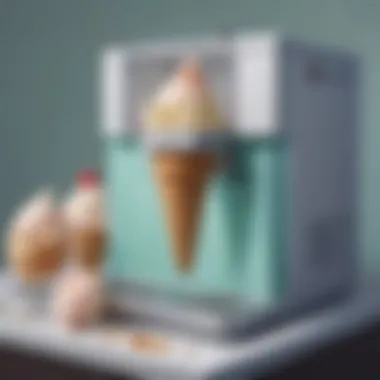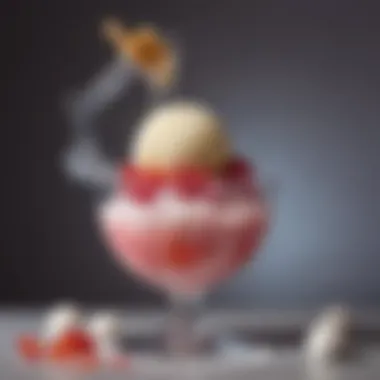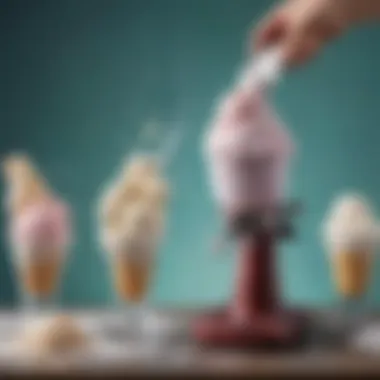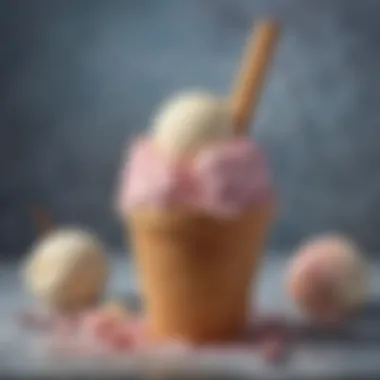Unlocking the Mysteries of Ice and Salt Ice Cream Makers for Young Science Enthusiasts


Science Fun Facts
Ice and salt ice cream makers are fascinating devices that harness the power of chemistry to create delicious frozen treats. Did you know that the addition of salt to ice lowers its freezing point, allowing the mixture to reach temperatures below 0 degrees Celsius? This unique property is crucial for ice cream creation and highlights the importance of understanding scientific principles in everyday activities.
Discover the Wonders of Science
In this section, we will delve into various scientific concepts that underpin the functioning of ice and salt ice cream makers. By exploring the principles of heat transfer, crystallization, and phase transitions, young learners will gain a deeper appreciation for the intricate processes involved in making their favorite dessert. Through engaging educational videos and interactive learning tools, children can visualize these concepts in action and apply their newfound knowledge to real-life scenarios.
Science Quiz Time
Test your scientific knowledge with interactive quizzes designed to challenge and educate aspiring ice cream scientists. Multiple choice questions and brain teasers will push participants to think critically about the mechanisms behind ice cream-making while honing their problem-solving skills. By gamifying the learning experience, children can enjoy the thrill of discovery and exploration in a fun and interactive way.
Science Experiment Showcase
Embark on a journey of scientific discovery with our collection of fun and engaging experiments using ice and salt ice cream makers. Follow step-by-step instructions detailing the materials needed, safety tips, and precautions to ensure a safe and exciting experimentation process. From observing the effects of varying salt concentrations on ice cream texture to exploring the role of agitation in freezing, each experiment offers a hands-on experience that stimulates curiosity and fosters a deeper understanding of the science behind frozen desserts.
Introduction
In the realm of Lab Littles, where young hearts and curious minds converge, the ice and salt ice cream maker stands tall as a beacon of scientific marvel. This guide is a portal into a world where dessert-making transcends mere deliciousness and becomes an enthralling experiment in chemistry. What makes this topic so compelling is its ability to merge education with delight, providing a sensory experience while unraveling the mysteries of freezing points and phase transitions.
As we embark on this exploration, we will peel back the layers of traditional desserts and reveal the scientific principles that underpin them. Understanding the mechanisms behind this ice cream-making process opens up a world of possibilities for young learners. Through hands-on engagement, they not only create creamy treats but also absorb fundamental scientific concepts without even realizing it.


Within the context of Lab Littles' target audience of 6-12-year-olds, the introduction of ice and salt ice cream makers serves as a captivating doorway into the world of science. By tapping into children's innate curiosity and introducing them to the intersection of food and chemistry, we spark an interest that can pave the way for future scientific explorations. This guide aims to lay a solid foundation for understanding the fascinating role science plays in everyday activities, all while having a scoop of fun along the way.
Understanding Ice and Salt Ice Cream Makers
In this insightful guide on Lab Littles, we delve into the intricacies of ice and salt ice cream makers, shedding light on a fascinating subject for young science enthusiasts. Understanding how ice and salt ice cream makers function is fundamental to mastering the art of creating delicious frozen treats. By comprehending the scientific principles behind this process, children aged 6-12 can enhance their knowledge of thermodynamics and phase transitions.
Ice and salt ice cream makers operate on the principle of lowering the freezing point of water through the addition of salt. When salt is mixed with ice, it causes the ice to melt while absorbing heat from the surroundings. This absorption of heat leads to a reduction in temperature, enabling the mixture inside the ice cream maker to freeze effectively. By grasping this concept, young learners can appreciate the role of salt in facilitating the freezing process and producing smooth, creamy ice cream textures.
Materials Needed for Ice and Salt Ice Cream Maker
In the realm of creating delectable ice cream using ice and salt ice cream makers, the materials required play a pivotal role. Understanding and utilizing the right ingredients ensures a smooth and successful ice cream-making process. It is essential to gather high-quality components to achieve the desired creamy texture and delicious flavor in the final product. The ingredients adopted also influence the freezing point of the mixture, contributing significantly to the overall outcome.
When it comes to crafting a scrumptious batch of ice cream, it is crucial to prioritize freshness and quality. Start by selecting fresh dairy products like whole milk or heavy cream to establish a rich and luscious base. Sugar, in the form of granulated or caster sugar, serves not only as a sweetener but also plays a crucial role in the texture and consistency of the ice cream. Incorporating a pinch of salt enhances the flavors and helps regulate the freezing temperature effectively.
Additionally, don't overlook the importance of flavorings and extracts in intensifying the taste profile of your ice cream. Vanilla extract is a popular choice for adding a delicate essence, while other extracts like almond or mint can provide a unique twist to your creation. For those inclined towards indulgence, consider introducing chocolate chips, nuts, or fruit purees as mix-ins to elevate the complexity of flavors and textures. Remember, the key to a successful ice cream concoction lies in the meticulous selection and combination of high-quality ingredients.
List of Ingredients
- Whole Milk or Heavy Cream
- Granulated Sugar or Caster Sugar
- Salt
- Flavorings (e.g., Vanilla Extract)
- Optional Mix-ins (e.g., Chocolate Chips, Nuts, Fruit Purees)
In summary, the journey of crafting delectable ice cream with an ice and salt ice cream maker commences with acquiring the right materials. By carefully curating top-notch ingredients, you set the stage for a delightful and satisfying frozen treat. Stay tuned as we venture into the intricate process of transforming these basic components into a delightful indulgence for the taste buds.
Step-by-Step Guide to Making Ice Cream with an Ice and Salt Ice Cream Maker


In this section, we will delve into the essential process of making ice cream using an ice and salt ice cream maker. Understanding the step-by-step guide is crucial for achieving a delectable end result that will delight both the taste buds and the curious mind of a young scientist. Through following each step meticulously, children aged 6-12 can learn about the principles of freezing and the transformation of ingredients into a creamy treat. Mastering this guide will not only result in a tasty dessert but also enhance their scientific knowledge and experimental skills.
Step 1: Prepare the Ice Cream Mixture
To kick-start the ice cream making journey, the first and foremost step is crafting the perfect ice cream mixture. This stage is fundamental as it sets the flavor profile and texture of the final product. Young scientists need to meticulously measure and combine the ingredients, usually consisting of milk, cream, sugar, and flavorings. The blending process is a critical step that ensures a homogeneous mixture, ready to undergo the freezing transformation. This step offers a hands-on experience for children to understand the science behind emulsification and the role of each ingredient in creating a delicious ice cream base.
By comprehensively covering the process from preparing the mixture to freezing, children can witness the miraculous science of phase change and crystallization. Encouraging them to engage actively in each step fosters not only a love for ice cream but also a passion for experimentation and understanding the natural world around them. Making ice cream with an ice and salt ice cream maker becomes a delightful learning experience that marries culinary arts with scientific exploration, offering a memorable activity for young minds to cherish.
Factors to Consider When Using an Ice and Salt Ice Cream Maker
Ice cream making using an ice and salt ice cream maker is a delightful science-filled activity that requires careful consideration of various factors to ensure a successful outcome. One key element to contemplate is the proportion of ice to salt ratio. Achieving the right balance is critical as it affects the rate of freezing the ice cream mixture. Another essential factor to keep in mind is the temperature of the ingredients. Ideally, the ingredients should be chilled before mixing them to promote faster freezing. Moreover, the type of salt used plays a crucial role. Typically, rock salt or kosher salt is recommended due to its ability to lower the freezing point of the ice, aiding in the freezing process. Additionally, monitoring the consistency of the ice cream during churning is vital. The texture can be affected by various factors such as the speed and duration of churning, which influence the formation of ice crystals. Thus, being attentive to these factors will result in smooth and creamy ice cream.
Adjusting Freezing Time
Adjusting the freezing time when using an ice and salt ice cream maker is a crucial aspect that significantly impacts the final outcome of the ice cream. The freezing time is determined by several factors, including the quantity of the ice cream mixture, the temperature of the ingredients, and the efficiency of the ice cream maker. A general rule of thumb is to freeze the mixture for approximately 20-30 minutes to achieve a semi-frozen consistency before transferring it to the ice and salt mixture container for further churning. However, adjusting the freezing time based on the desired texture is essential. Longer freezing times result in firmer ice cream, while shorter freezing times yield a softer consistency. Experimenting with different freezing times allows for customization according to personal preference. It is advisable to periodically check the consistency of the ice cream during the freezing process to achieve the desired texture. By understanding how freezing time affects the final product, ice cream enthusiasts can tailor their recipe to perfection.
Troubleshooting Tips for Ice and Salt Ice Cream Maker
In the pursuit of mastering the art of crafting delectable ice cream using the ice and salt ice cream maker, understanding troubleshooting tips is critical. Troubleshooting tips act as the guiding light in navigating potential challenges that may arise during the ice cream-making process, ensuring a smooth and successful culinary journey for science enthusiasts on Lab Littles. By comprehending the nuances of troubleshooting tips, young learners can develop problem-solving skills and enhance their scientific reasoning abilities, making the entire experience more enriching and educational.
One of the key elements to consider when delving into troubleshooting tips for the ice and salt ice cream maker is the effect of external factors on the freezing process. Factors such as ambient temperature, quality of ice and salt used, and the sealing of the ice cream maker can significantly impact the outcome of the freezing process. By addressing these factors proactively and learning how to troubleshoot issues related to them, young scientists can gain a deeper understanding of the intricate interplay between variables in the kitchen laboratory.


Ice Cream Not Freezing
When encountering the perplexing issue of ice cream not freezing in the ice and salt ice cream maker, it is essential to remain calm and approach the situation methodically. One of the primary reasons for this common hiccup is a lack of sufficient salt in the ice surrounding the inner container. The salt plays a crucial role in lowering the freezing point of the ice, facilitating the rapid heat transfer required for freezing the ice cream mixture.
Another factor to consider when troubleshooting the freezing dilemma is the consistency of the ice cream mixture. If the mixture is too runny or lacks adequate fat content, it may struggle to freeze properly in the designated time frame. In such instances, adjusting the recipe by adding ingredients with higher fat content or thickening agents can assist in achieving the desired freezing consistency.
Patience and precision are key virtues when addressing the issue of ice cream not freezing in an ice and salt ice cream maker. By fine-tuning the salt-to-ice ratio, optimizing the ice cream mixture composition, and diligently monitoring the freezing process, young scientists can overcome this challenge and emerge with a newfound appreciation for the art and science of ice cream making.
Exploring Variations and Flavors with Your Ice and Salt Ice Cream Maker
When delving into the realm of ice and salt ice cream makers, one cannot overlook the significance of exploring variations and flavors. This aspect adds a layer of creativity and excitement to the ice cream-making process, making it a truly engaging and rewarding experience for young science enthusiasts on Lab Littles. By experimenting with different flavors and mix-ins, children not only enhance their understanding of scientific principles but also unleash their imagination and innovation. It goes beyond just making ice cream; it is about fostering a sense of curiosity and exploration in a laboratory-like setting.
Incorporating mix-ins and exploring various flavors is essential for young minds to grasp the concept of how ingredients interact and affect the final product. It introduces them to the concept of experimentation and encourages them to think critically about taste combinations and textures. This hands-on approach not only makes learning enjoyable but also instills valuable skills such as observation, deduction, and problem-solving. Moreover, by allowing children to customize their ice cream flavors, it promotes autonomy and boosts their confidence in their scientific abilities.
Incorporating Mix-Ins
Within the realm of ice cream making, incorporating mix-ins stands as a crucial and exciting step. This process involves adding supplementary ingredients such as chocolates, fruits, nuts, or candies to the ice cream mixture to enhance its flavor and texture. The task of incorporating mix-ins provides young learners with an opportunity to experiment with different combinations, understand how each element influences the overall product, and develop a sense of ownership over their culinary creations.
When incorporating mix-ins, children can explore the concept of balance in flavors, ensuring that each addition complements the base ice cream mixture harmoniously. This exercise sharpens their palates, teaches them about flavor profiling, and encourages them to think critically about taste pairings. Furthermore, the tactile experience of adding mix-ins allows for a sensory-rich learning environment, where children can observe, touch, smell, and taste various ingredients firsthand, deepening their understanding of culinary alchemy.
Conclusion
In the realm of ice and salt ice cream makers, the Conclusion serves as the ultimate guidepost for young Science enthusiasts traversing the fascinating landscape of frozen treats. This pivotal section encapsulates the essence of the article, offering not just a summary but a reflection on the journey undertaken. For children aged 6-12, grasping the significance of Conclusion is akin to unlocking a hidden treasure chest of knowledge and creativity.
As Lab Littles embarks on this scientific escapade, the Conclusion acts as a beacon, illuminating the path toward a deeper understanding of the intricate process behind ice cream making. It consolidates the learning acquired throughout the guide, reinforcing the importance of patience, precision, and scientific curiosity. This section paves the way for young minds to appreciate the fusion of art and science involved in creating delectable frozen desserts.
Moreover, the Conclusion serves as a call to action, encouraging fledgling scientists to experiment fearlessly and push the boundaries of their culinary endeavors. It instills the belief that with each batch of homemade ice cream churned, there lies a world of possibilities waiting to be explored. By emphasizing the relevance of Conclusion, Lab Littles motivates young learners to embrace challenges, celebrate failures, and relish the sweet rewards of their scientific inquiries.
In essence, the Conclusion is not merely the endpoint of a guide but the commencement of a perpetually evolving scientific journey for aspiring ice cream connoisseurs. It underscores the triumphs of exploration, the beauty of experimentation, and the joy of discovery, leaving the readers inspired to continue their quest for knowledge in the enchanting realm of ice and salt ice cream makers.







